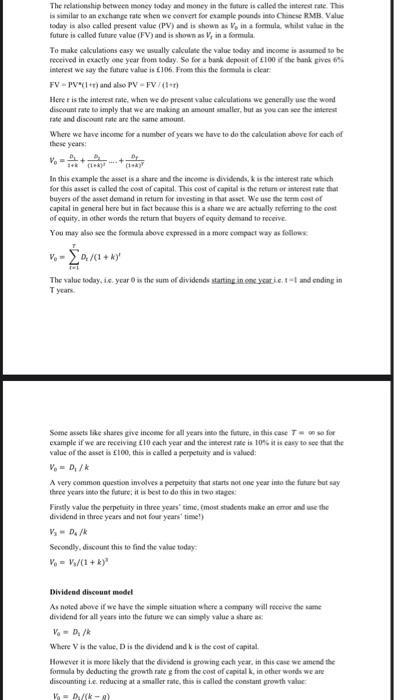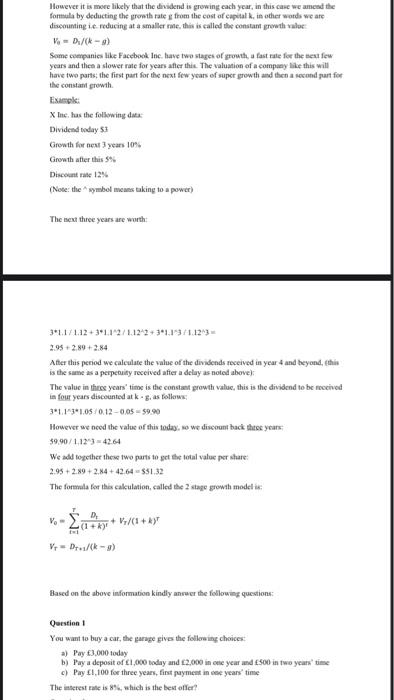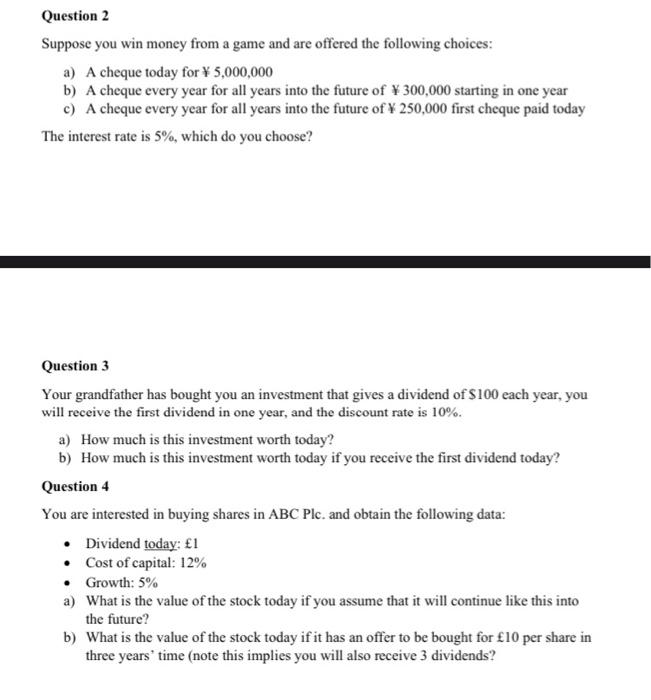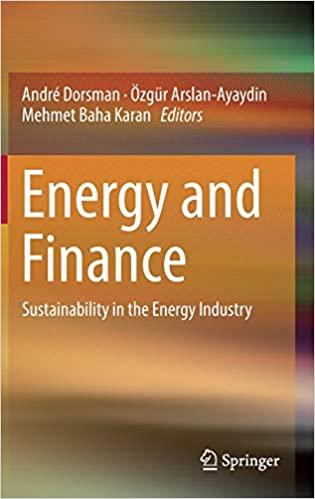The relationship between money today and money in the future is called the interest rate. This la similar to an exchange rate when we convert for example pounds into Chinese RMB. Value Today is also called present value (PV) and is shown as V, in a formula, whilst value in the future is called future valoe (FV) and is shown as V, in a formula To make calculations cay we usually calculate the value today and income is assumed to be received in exactly one year from today. So for a bank deposit of 100 if the bank gives interest we say the future value is 106. From this the formula is clear FV-PV"1+r) and also PV-FV7(+r) Here is the interest rate when we do present value calculation we generally use the word discount rate to imply that we are making an amount smaller, but as you can see the interest rate and discount rate are the same amount Where we have income for a number of years we have to do the calculation above for each of these years A In this example the set isa share and the income is dividends, is the interest rate which for this asset is called the cost of capital. This cost of capital is the retumor interest rate that buyers of the asset demand in return for investing in that act. We use the term cost of capital in general here but in fact because this is a share we are actually referring to the cost of cquity, in other words the return that buyers of equity demand to receive You may also see the formula above expressed in a more compact way as follow V D./(1+x)' The value today, ie year in the sum of dividends starting an encantie 1 - and ending in Some assets like shares give income for all years into the future in this case Tons for example if we are receiving 10 cach year and the interest rate is 10% it is casy to see that the value of the asset is 100, this is called a perpetuity and is valued V - DK A very common question involves a perpetuity that starts not one year into the future but say three years into the future, it is best to do this in two stager Firstly value the perpetuity in three years' time, most students make an error and use the dividend in three years and not four years' time! Secondly, discount this to find the value today Vo = W/(1+)' Dividend discount model As noted above if we have the simple situation where a company will receive the same dividend for all years into the future we can simply value a share a V-0./ Where is the value is the dividend and is the cost of capital However it is more likely that the dividend is growing cach year, in this case we amend the formala by deducting the growth rate from the cost of capital k, in other words we are discounting i.e. reducing at a smaller rate, this is called the constant growth value VD/(- However it is more likely that the dividend is growing each year, in this case we amend the formula by deducting the growth rate from the cost of capital in other words we are discounting ie reducing at a smaller rate, this is called the constant growth valor V-D/-) Some companies like Facebook Inc. have two stages of growth fast rate for the next few years and then a slower rate for years after this. The valuation of a company like this will have two parts: the first part for the next few years of super growth and then a second part for the constant growth Example X Inc. has the following die Dividend today 51 Growth for next 3 years 10% Growth after this 59. Discount rate 12% (Note: the symbol means taking to a power) The next three years are worth 3117112 + 31.1-2/ 1.12-2 31.3/1.123 2.95 +2.89 +2.84 After this period we calculate the value of the dividends received in year and beyond this is the same as a perpetuity received after a delay as noted above The value in three years time is the constant growth value, this is the dividend to be received in four years discounted atk. s. as follows 311*3*1.05 0.12 -0.05 59.90 However we need the value of this today, so we discount back three years 39.90/1.1234264 We add together the two parts to get the total value per share 2.95 +2.89 +2.84 +4264-55132 The formula for this cakulation, called the 2 stage growth model V + V Dre/k-) Based on the above information kindly answer the following questions Question 1 You want to buy a car, the garage gives the following choices a) Pay 3.000 today b) Paya deposit of 1,000 today and 2,000 in one year and 500 in two years' time c) Pay 1,100 for three years, first payment in cee years' time The interest rate is 19, which is the best eller? Question 2 Suppose you win money from a game and are offered the following choices: a) A cheque today for 5,000,000 b) A cheque every year for all years into the future of 300,000 starting in one year c) A cheque every year for all years into the future of 250,000 first cheque paid today The interest rate is 5%, which do you choose? Question 3 Your grandfather has bought you an investment that gives a dividend of $100 each year, you will receive the first dividend in one year, and the discount rate is 10%. a) How much is this investment worth today? b) How much is this investment worth today if you receive the first dividend today? Question 4 You are interested in buying shares in ABC Plc. and obtain the following data: Dividend today: 1 Cost of capital: 12% Growth: 5% a) What is the value of the stock today if you assume that it will continue like this into the future? b) What is the value of the stock today if it has an offer to be bought for 10 per share in three years' time (note this implies you will also receive 3 dividends









